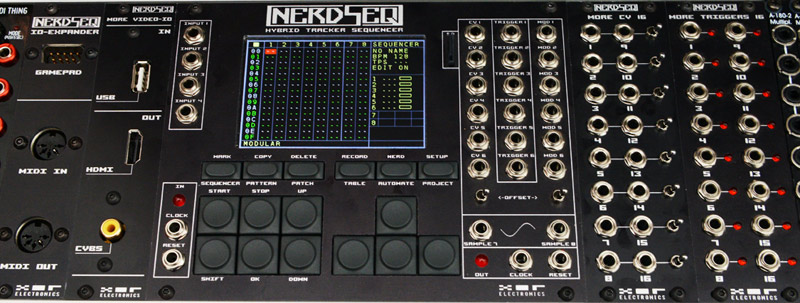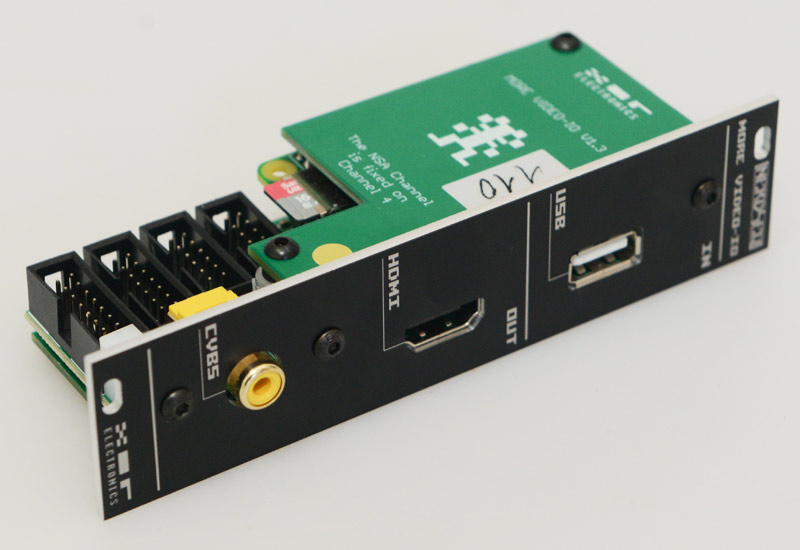XOR Electronics NerdSEQ - Part 2
Author and photos: Peter Kaminski
A lot has happened with the NerdSeq since our last report (XOR NerdSeq Part 1), and there are some new features that we would like to draw your attention to in this second part, both in terms of firmware 1.25 released in October 2021 and in terms of hardware options.
2HP MIDI expander
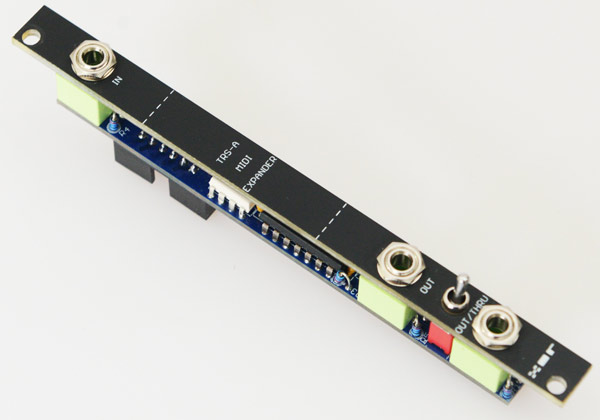
Letˊs start with the hardware options. As an alternative to the I/O expander with MIDI interface (inputs and outputs designed as 5-pin DIN sockets), the new MIDI interface with a width of just 2 HP offers a MIDI In and a MIDI Out as well as an additional switchable output that can be used as a MIDI Thru or second MIDI Out via a mini toggle switch.
All MIDI I/Os were designed as 3.5-mm jack sockets (TRS-A). Three adapters from TRS-A to 5-pin DIN are also supplied. TRS-B MIDI devices can also be connected using optional adapters. However, you have to choose one of the two MIDI interfaces because only one MIDI interface can be connected to the NerdSeq. The 2HP MIDI expander costs slightly over 40 euros. The front panel is not made of metal, but of Expoxy, printed in black with white lettering.
CV16-Expander
We briefly mentioned the CV16 expander in the first part; however, we would like to take a closer look at the module and its functionality in the second part.
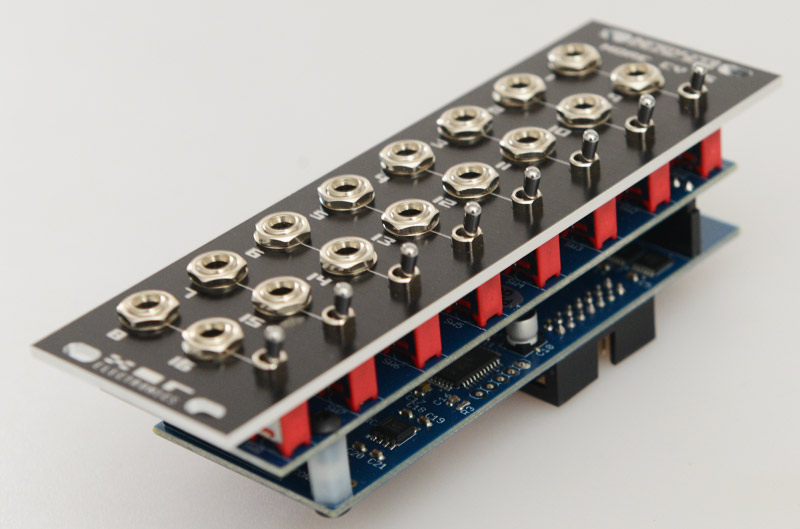
The CV16 expander has 16 CV outputs (3.5 mm jack sockets). One pair each (1/9, 2/10 ... 8/16) can be selected in the voltage range of -5 ... +5 or 0 ... +10 volts via a miniature toggle switch.
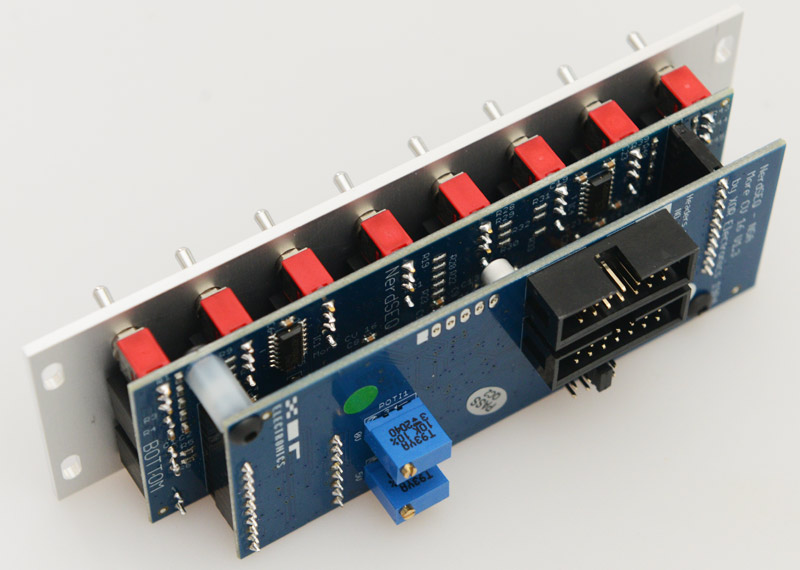
The module is not merely a D/A converter; it is also equipped with a microcontroller. It also supports the output of LFOs or envelopes. But more on this later. The price of the 16CV expander is less than 160 euros. The module is available in three versions: gray, black, and gray/black (black with gray edge).
Video expander
The video module is a relatively new and offers a wide range of functions. It is connected to the NSA and MIDI bus. However, it is still possible to operate a MIDI expander as usual. The video expander appears in the system as NSA slot 4. The module must also be connected to the MIDI bus. The cables for the connection are, of course, included in the module.
The NerdSeq screen can also be output to a monitor via composite or HDMI output (Type A) using the video expander. We immediately used this to create the screen shots for our article.
The video expander also has a USB-A socket toconnect a computer keyboard. This port can be used to call up all dialogs and make parameter settings. The advantage of this is that many functions can be accessed using the computer keyboard, if necessary with the help of the Shift or CTRL keys. Note values can also be entered using the letters. Using a keyboard on the NerdSeq not only creates a "tracker" sequencer feeling, but in conjunction with a connected HDMI monitor, the entire NerdSeq can be operated remotely, and if you have practiced and memorized all the key assignments, the operation is even more convenient than via the NerdSeq itself. However, there were also USB keyboards in our test that did not work. However, connecting a USB hub in between could provide a solution. There were no problems with wireless Logitech keyboards, for example. I would recommend a wireless keyboard anyway.
There is also an SD card in the video module itself. However, the module firmware is conveniently updated directly via the NerdSeq itself. The cost of the video expander is less than 230 euros, and it is also available in three versions: gray, black, and gray/black.
Launchpad Support
One function that has been implemented for some time is the integration of NerdSeq control via Launchpad. Officially, Launchpad support for version 1.25 is still marked as "beta status". However, this is simply an understatement because the launchpad control works in practice without any problems and is very helpful. However, developer Thomas Margolf wants to implement even more launchpad functions.
The Launchpad Mini, Launchpad MK2, Launchpad Pro, and Pro MK3 are supported. The list is expected to be expanded to include newer models. Depending on the Launchpad type, you may need to use USB/MIDI converters. The Launchpad Pro has direct MIDI inputs and outputs that are simply connected to the MIDI interface of the NerdSeq.
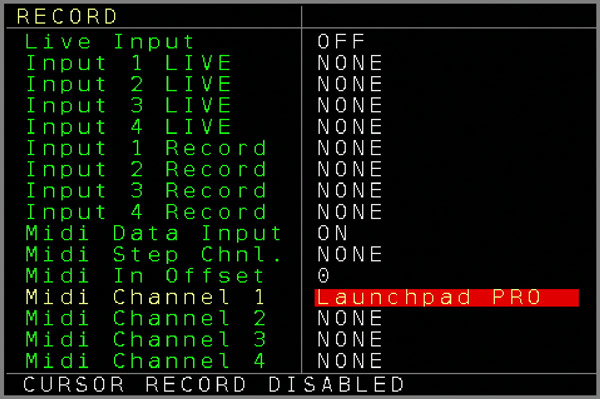
Activating Lauchpad support is relatively simple. All you have to do is select your Lauchpad model in the "Project" menu in the "MIDI Input / Record" submenu (see illustration above) for MIDI channel 1, and then "MIDI Data Input" must be activated ("ON"), and that's it.
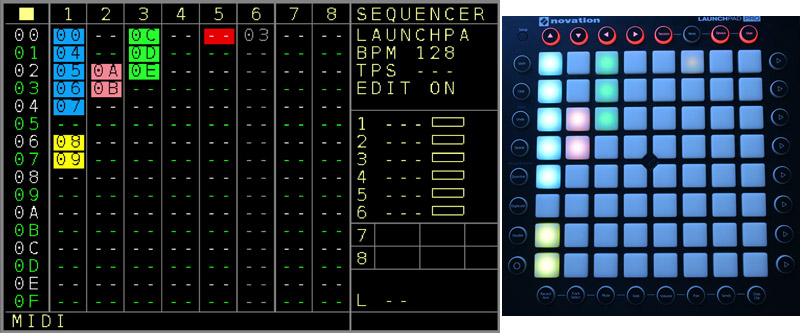
The functionality is adapted depending on the selected NerdSeq screen. The sequencer screens (see illustration above) provide a comprehensive overview of the patterns. The display corresponds to the display on the NerdSeq, also in terms of the colors. Therefore, it makes particular sense to assign a color to patterns or tracks via the Nerd menu.
The round buttons at the top and right sides also have a function. The upper ones can be used to solo or mute tracks. The colors also indicate whether a track is playing (green), not playing (red), or muted (indicator LED is then off). The following functions can be called up using the right-hand buttons: Up, Down, Enter Pattern, Clock Scale, Reset Clock Scale, Stop, Jump and a Shift function (lowest of the round buttons on the right).
If you tap a button in sequencer mode or on the launchpad screen, the sequencer is started, and the pattern is played back. This is particularly helpful for live improvizations. The current position in the sequencer is also displayed in play mode.
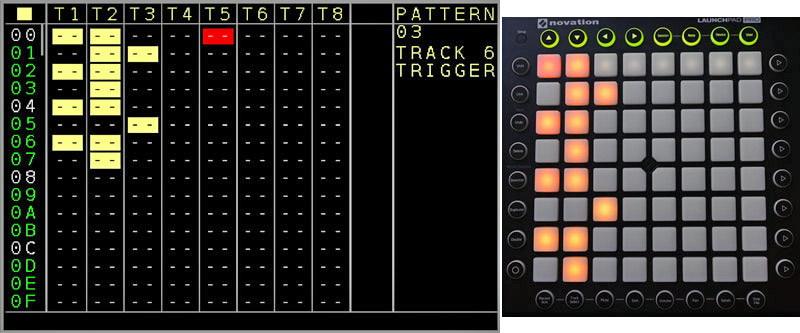
When a pattern is opened, the corresponding entries are also displayed. This is particularly useful for patterns whose track are assigned to a MORE TRIGGERS 16 module (see illustration above). Here, you can program drums/percussion very easily and quickly using the launchpad via the drum matrix page.
LFOs and envelopes
The NerdSeq has eight internal envelope generators. The corresponding menu can be accessed by pressing AUTOMATE twice (see illustration below).
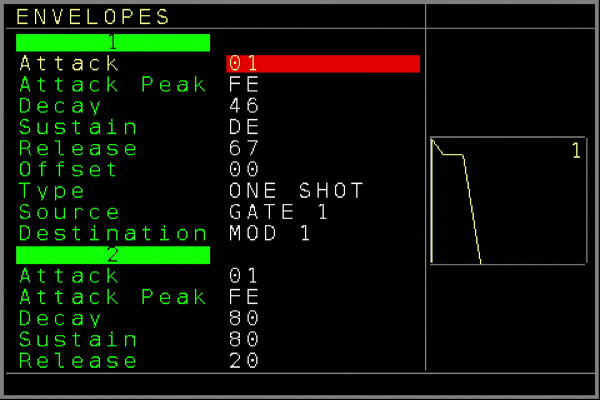
Each of these represents an ADSR envelope. In addition to the ADR times (relative times) and the sustain level, the triggering source (gate of track 1 in the example above) and destination (modulation output 1 in the example above) can be selected. There are three trigger types that can be set via the TYPE parameter: "ONE SHOT", which means that the envelope is output for each trigger without taking the gate length into account; "AD-SR", where the gate length (sustain phase) is taken into account, and "LOOP", i.e. the envelope in continuous repetition.
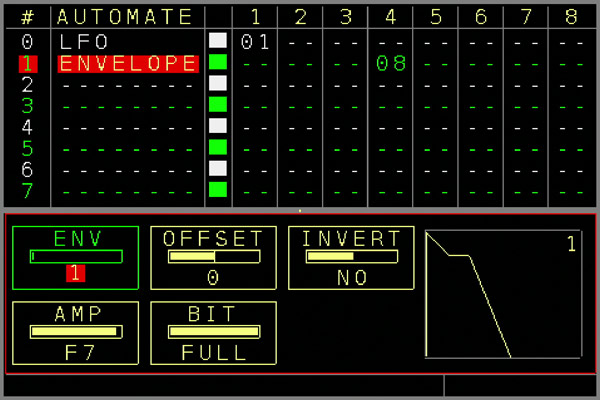
You can also modulate signals using the existing LFOs and envelopes. The modulation matrix for this can also be selected via the AUTOMATE menu (see illustration above). This allows the realization of very complex processes.
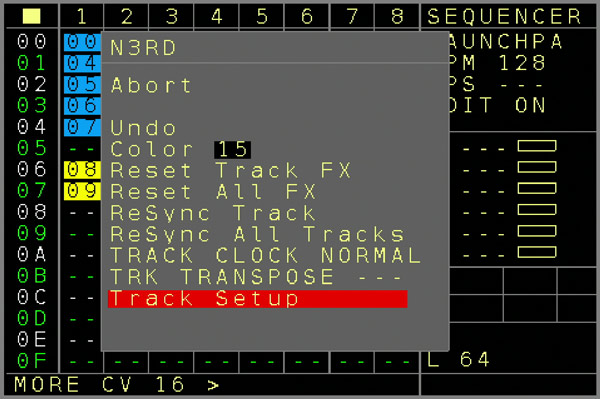
The CV16 module also offers eight ASR envelopes. These can be set via the NERD menu and the TRACK SETUP menu item when the corresponding track is selected.
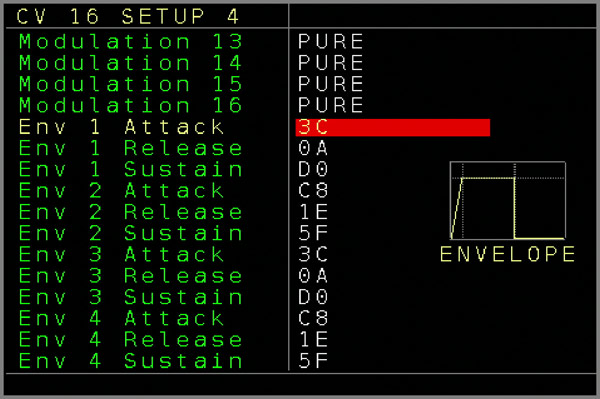
If you scroll down there, the parameters of the CV16 envelope generators will appear (see illustration above).
More news
The list of news from one NerdSeq firmware version to the next is typically several pages long. Therefore, we would like to point out some particularly noteworthy and important new features. All features listed here are included in version 1.25.
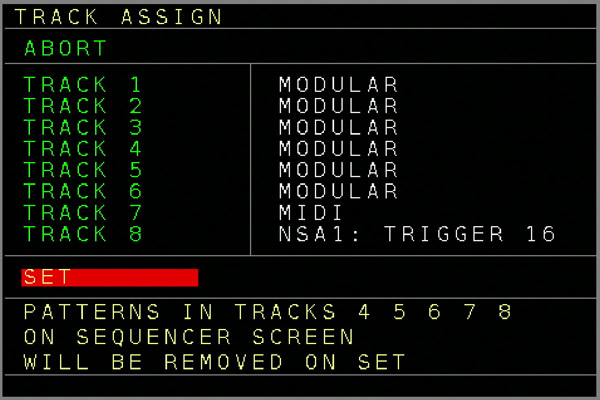
One of the most important enhancements for me personally is that tracks 7 and 8 are no longer only for audio/samples, but can also be assigned as required. Thus, you can now use all six modularoutputs to a track and can, for example, use track 7 for MIDI and track 8 for drum triggers.
From version 1.22, the NerdSeq also offers an FM synthesis engine with four operators, as well as a wavefolder function, and a lo-fi delay effect. Certainly a nice gimmick. These functions should probably be seen as add-ons.
A lot has also happened in the area of tables. New table functions for random functions, scales, chords, and disallowed notes have been added, and table presets for double notes, triplets, and various chords, for example, are also available via the nerd menu. The trigger specification above the E0 values now has values for ratcheting and random functions.
Polyphonic recording via MIDI is now also supported for CV/gate tracks. There are also some minor enhancements in the MIDI tracks area. For example, the MIDI channel can also be recorded and played back via the track-follow-MIDI function. As I mentioned, the feature lists for the new version are several pages long.
Conclusion
We are already anticipating that there will be a third part of our review of the NerdSeq, as development continues, and there will be innovations in both firmware and hardware. However, we would like to draw a more comprehensive conclusion at this point.
The NerdSeq has a unique selling point in that it is the only truly modular sequencer in Eurorack format. Owing to its wide variety of modules, it is very adaptable and can also be expanded if necessary.
The operation is basically based on the trackers of earlier times of electronic music. Not everyone will be enthusiastic about dealing with hexadecimal entries. In many respects, the name NerdSeq also says it all, although this is not meant in a negative way. Due to the very high complexity of the sequencer, many hidden functions are present, and it is necessary to really get to grips with the product. Switching on and working without ever having looked at the operating instructions is certainly not possible. You first need to understand the basic concept. However, the operating instructions are very comprehensive and helpful. I would like to see more practical examples in the corresponding instructions.
If you spend more time with the NerdSeq, youˊll continue to discovering new functions. Thanks to the Launchpad control option, the NerdSeq is also practical for use at live events. If you need a lot of tracks, are more interested in programing than in live recording, and also want to do drum/percussion programing, the NerdSeq will undoubtedly appeal to you. Especially those who want to control complex setups with a sequencer will benefit from the enormous performance spectrum of the NerdSeq.
 How to resolve AdBlock issue?
How to resolve AdBlock issue? 